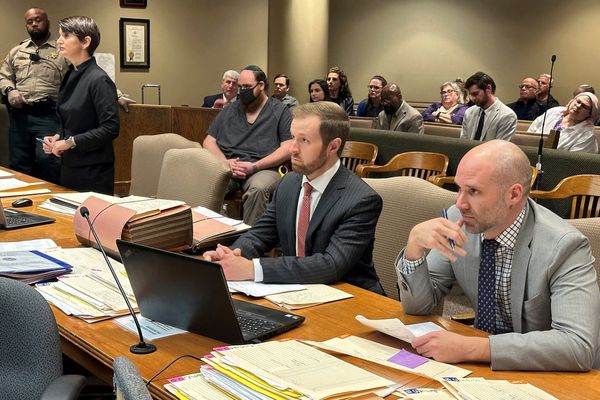Most adults wouldn't even think of "playing" outside, but with parkour, Amy Han does just that.
Amy is not jumping off any buildings though. She's there for the softer side of parkour, that almost anyone can do.
"I can't think of a better way to incorporate movement and exercise and play into life," she said.
"I don't really think about it as training, I just think about it as going outside. I'm just going outside to move."
The discipline was founded in Paris in the 1990s.
"Parkour is based in functional movements like running, climbing, jumping, etc., and in play and curiosity," Women of Parkour Melbourne coach Kel Glaister said.
"It's all about using the capacity of your own body to explore and play in your environment."
'It felt like being on a playground'
Amy's introduction to parkour was in a gym room in London, about 10 years ago. A friend invited her to a class because he thought she'd like it. Curious, Amy went along with her friend.
They entered a room full of gymnastics equipment and watched as the instructor moved across the obstacles to get to the other side. Amy had never been sporty, but for the next two hours she moved, people helped her and they helped each other.
"Although it was hard, it didn't feel like exercise — it felt like being on a playground," she said.
The parkour class came at a pivotal time in Amy's life when things were heavy and disheartening. She said she connected with parkour in a metaphorical sense.
"I came to this class and [said to myself]: 'Here are all the obstacles, it doesn't matter how you go over them, just find your way. It doesn't matter if you scramble over them, if it takes you a long time, if you have to try a few times, just get through to the end'," she said.
The power of visibility
After that first class, Amy moved rapidly from participant to instructor, working with Melbourne Parkour for several years.
She said people were often surprised to see her as an instructor because they weren't expecting a woman. But Amy believes a lot of women stayed because of her.
The taller and stronger male instructors would be able to step up and pop themselves over a wall, but Amy would have to take a big run-up and use a rail as a step before hopping up onto the wall.
"I'd say: 'This is the way that this person would move over the obstacle because that's the most-efficient way for them, but for me, I'm going to have to find another way because I'm not 6-foot tall, and I don't have the same level of upper body strength'," she explained.
"If you have a female instructor, more girls will join because it shows it's for them too. And I think that applies for all kinds of diversity."
Women of Melbourne Parkour is one organisation working to diversify the sport.
"It's a discipline that remains dominated by young men," Glaister said.
"But there are loads of people and organisations worldwide working to change that, to make space for more people — of all genders, ages, abilities and backgrounds — within parkour.
"Women of Melbourne Parkour is one of those organisations, and we have regular training sessions that [cater for] women and other genders."
Growing up, Amy said she was told not to do the types of jumping and climbing inherent in parkour because they were dangerous, and she would hurt herself.
However, her brother was never given the same caution.
"For me, it was a huge 'unlearning' and almost like a new childhood when I discovered parkour," she said.
For Amy, parkour is more about play and movement than rigid training.
"As adults, we don't give ourselves permission to play enough," she said.
"It's always, 'I'm going out to train' or 'I'm going to the gym', for a specific purpose. But how many adults just go out to play?"
'Possible but scary' — learning how to bail
Amy said she believed in the maxim "find your own way", not just in parkour, but in life.
There's a common misconception that parkour is just big jumps and jumping off rooftops.
However, Amy said, parkour was different for each person. It doesn't have to be about the big jumps. It can also be about smaller movements.
"It can be just walking around on a rail," she said..
"It can be just going to a playground and finding a challenge for yourself, it can be a park bench. It can be just looking at a park bench and thinking, 'How many ways can I move over this park bench'?"
Amy's favourite technique, she said, was balancing. She walks on rails a lot and, often, if she's on her own, she'll go to a local oval and set herself the challenge of walking on the fence around the oval without falling off.
"You need to be strong, but you need to have fun with it. It's just a balance of all different things," she said.
Amy said it was also about gaining the confidence to approach things that might look uncomfortable, with the knowledge that they were still possible.
"Every training session I try to find that point where it looks possible but scary," she said.
Parkour is also about learning how to bail.
If Amy slightly misses a jump, she knows how to fall in a way that doesn't end in hurting herself.
This means reminding herself that the worst thing that can happen is landing on her bum.
"In parkour, you will fall sometimes, but we learn very early how to fall," she said.
Existing fitness base isn't necessary
While many people believe they need to get fit before they start parkour, Amy said that was not the case.
"You get stronger by starting," she said. "Just start. Everybody in the parkour community is super friendly. If you feel drawn to it, just give it a try."
She recommended finding your local community or classes, like Women of Parkour Melbourne.
These days, there's an increasing variety of male and female instructors who come from all different backgrounds.
Amy said it would be fantastic to see more girls and women involved in the sport.
"I would love to see more girls doing parkour from a young age and being shown what they're capable of — that they don't have to be afraid of everything and they don't always need someone to help them," she said.
Although Amy doesn't coach parkour anymore, parkour is integrated into her life and is a part of her lifestyle.
She still does parkour two to three times a week, both indoors and outdoors, in a class, with friends or by herself.
She said she wanted to keep moving until she gets old, however, she wanted to keep doing it in the playful way she was doing it now.
"I want to just keep having fun with it and challenging myself, but in a sustainable way," she said. "Always playing."
ABC Sport is partnering with Siren Sport to elevate the coverage of Australian women in sport.
Julie Dickson is a freelance writer based in Melbourne. She is studying a Bachelor of Psychology (Honours) at Deakin University and was recently an intern with ABC Sport.







